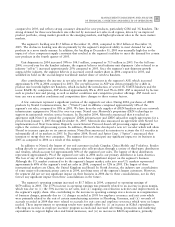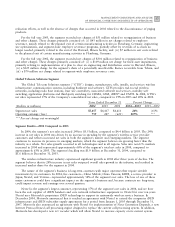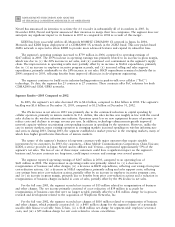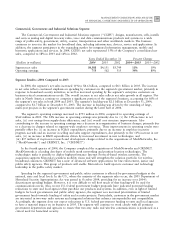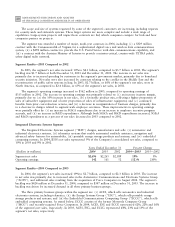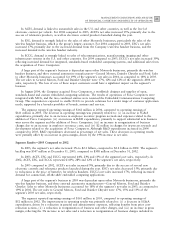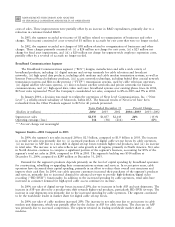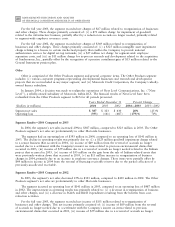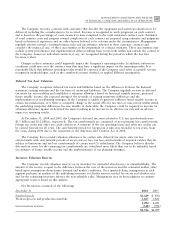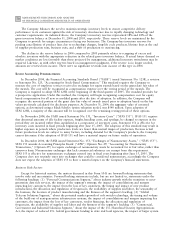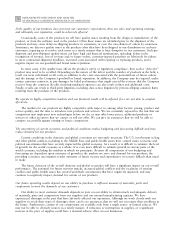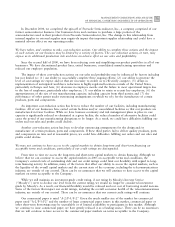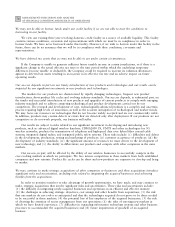Motorola 2004 Annual Report Download - page 73
Download and view the complete annual report
Please find page 73 of the 2004 Motorola annual report below. You can navigate through the pages in the report by either clicking on the pages listed below, or by using the keyword search tool below to find specific information within the annual report.
65
MANAGEMENT'S DISCUSSION AND ANALYSIS
OF FINANCIAL CONDITION AND RESULTS OF OPERATIONS
needed related to the Iridium project that occurred in 2003, and (iii) income of $33 million on the gain on the sale
of Iridium-related assets that were previously written down that occurred in 2003.
For the full year 2002, the segment recorded net charges of $34 million related to reorganization of businesses
and other charges. These net charges primarily consisted of: (i) $56 million in net charges for Ñxed asset
impairments, (ii) $46 million in net charges for segment-wide employee separation costs, and (iii) $16 million in
net charges for exit costs, partially oÅset by: (i) income of $63 million for Iridium vendor termination settlements
and the related reduction of accruals no longer needed, and (ii) income of $24 million for the reduction of
accruals no longer needed due to the settlement with the Company's insurer on items related to previous
environmental claims.
2005 Change in Organizational Structure
In December 2004, the Company announced a reorganization of its businesses and functions to align with the
Company's seamless mobility strategy, which was eÅective on January 1, 2005. The Company will be organized into
four main business groups, focused on mobile devices, networks, government and enterprise, and the connected
home. The Mobile Devices business will be primarily comprised of the current Personal Communications segment
and the Energy Systems group from the Integrated Electronic Systems segment (""IESS''). The Networks business
will be primarily comprised of the current Global Telecom Solutions segment, the Embedded Computing and
Communications group from IESS, and the next-generation wireline networks business from the Broadband
Communications segment (""BCS''). The Government and Enterprise business will be primarily comprised of the
current Commercial, Government and Industrial Solutions segment and the Automotive Communications and
Electronics Systems group from IESS. The Connected Home business will be primarily comprised of the current
BCS, excluding the next-generation wireline networks business. In addition, the Company's key support functions,
including supply-chain operations, information technology, Ñnance, human resources, legal, strategy and business
development, marketing, quality and technology will be architected centrally and distributed throughout the
Company. The Company will be aligned into these four main operating segments with the analysis of reportable
segments to be completed in the Ñrst quarter of 2005.
SigniÑcant Accounting Policies
Management's Discussion and Analysis of Financial Condition and Results of Operations discusses the
Company's consolidated Ñnancial statements, which have been prepared in accordance with U.S. generally accepted
accounting principles. The preparation of these Ñnancial statements requires management to make estimates and
assumptions that aÅect the reported amounts of assets and liabilities and the disclosure of contingent assets and
liabilities at the date of the Ñnancial statements, as well as the reported amounts of revenues and expenses during
the reporting period.
Management bases its estimates and judgments on historical experience, current economic and industry
conditions and on various other factors that are believed to be reasonable under the circumstances. This forms the
basis for making judgments about the carrying values of assets and liabilities that are not readily apparent from
other sources. Actual results may diÅer from these estimates under diÅerent assumptions or conditions.
Management believes the following signiÑcant accounting policies require signiÑcant judgment and estimates:
Ì Valuation of investments and long-lived assets
Ì Restructuring activities
Ì Allowance for losses on Ñnance receivables
Ì Retirement-related beneÑts
Ì Long-term contract accounting
Ì Deferred tax asset valuation
Ì Inventory valuation reserves


